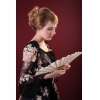|
 The XX
century proves to be the cradle where various styles originated from. And in the
end of the century before last all those tendencies originated which are used
by many fashion designers till now. The fashion of the XX century did not
manage without revolutionary inventions and first couturiers were revealed due
to those brave and courageous actions. The XX
century proves to be the cradle where various styles originated from. And in the
end of the century before last all those tendencies originated which are used
by many fashion designers till now. The fashion of the XX century did not
manage without revolutionary inventions and first couturiers were revealed due
to those brave and courageous actions.
The French Revolution
had a great influence on the state of the European fashion of the early XX century
when the aristocratic splendor, satin and laces, massive wigs of XVIII century
were replaced by the simple and less formal styles and even the most inveterate
French fashionmongers did not dare to look as noble people from high society.
In the meantime the fashion revolution went on in the neighboring Great Britain when
trousers and elegant dandy suits were found to be exceedingly popular and women
protested and refused from wearing girdles in favor of the high waistline
ensembles and natural look of clothes.
The Victorian
epoch opened in the 30s of XIX century brought exclusively new and fresh trends.
One of specific trends among the others is the birth of extremely puffy sleeves
of dresses, the fluffiest detail of the garment throughout the history of women
dresses. The fluffy skirts came to be fashionable again which seemed to lose demand
previously. The symbol of the womanly style of the Victorian epoch was such a hyperbolized
silhouette of hour-glass when the fashionable woman had to have a fluffy
conical skirt, too thin waist achieved with the help of girdles and puffy
sleeves. As a rule, evening ensembles provided for the seducing naked shoulders
while the dresses for everyday wear closed them. That was the time for laced pelerine
to cover open shoulders.
The classic
silhouette of hour-glass with the retreating shoulders, a bosom, a thin waist
and plum thighs were wholly highlighted by fashion designers in every possible
way mainly by tailoring and trimming. In the 30s of XIX century women achieved
incredibly thin waistline with the wide belts and specially designed girdles
sewn in gussets. Yet, the skirts were exclusively bulging to contrast and the
tailors made skirts of a record width from the crinoline. The shoulders were accentuated
by pelerines or a wide collar and skirts and dresses shortened to the ankle
line became longer to the floor.
Throughout the
entire XIX century the fashion underwent sea changes every decade, as it is
now. Fluffy skirts that turned fashionable in the early Victorian epoch lost
popularity and in the 70s of XIX century the European fashion turned favorable
for the narrow silhouette again.
The 70s were
marked with the developing influence of Pre-Raphaelites and other reformers who
struggled with the conventions of the Victorian epoch in all spheres of art.
Fashion was not the exclusion and women refused from wearing tightly-closed
girdles and fluffy crinoline skirts in favor of light and loose-styled dresses
and attires. Specially designed dresses for vocations came as gaudy and
frivolous dresses. Tremendously different apparel was demanding in the elite
society neglecting dresses with heavy drapery and rigid narrow girdles, the
ladies from bohemian society preferred wearing plain loose dresses carelessly
tied with a waist band.
To the end of
the XIX century women found the courage to refuse from extravagant apparel of
the previous years including fluffy skirts with crinoline though girdles were
still popular. Moreover, they became more rigid and tightly-closed. The classic silhouette of the end of the century
as the narrow bodice and a skirt draped at the waistline and gently fitting
thighs gradually widening to the bottom as the bell. Puffy sleeves outdated
completely so much loved by the fashionmongers of the Victorian epoch replaced
by the extremely tight sleeves, sometimes trimmed with ruches at the shoulder
line but tapering to the wrist, as a rule.
The end of XX
century was really revolutionary whereas women showed interest to sports
activity along with men, and first couturiers rushed to please ladies offering
special dresses to play tennis or cycling.
|